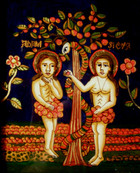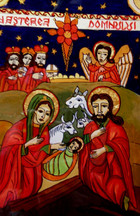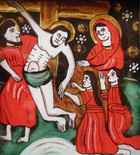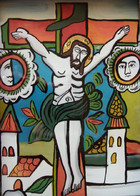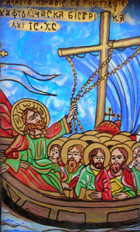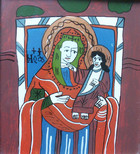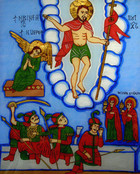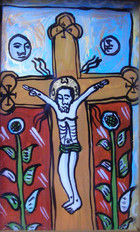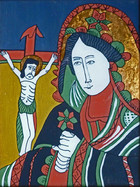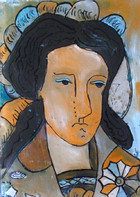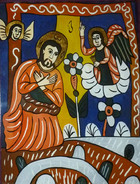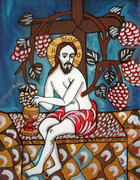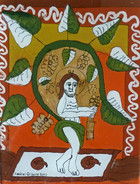Romanian Glass Icons
A two-story, white-washed plaster and wood frame building of special purpose stands across the cemetery from the 18th century church of Sibiel, a village in the Transylvanian region of Romania, located 22 km. southwest of the historic cultural center of Sibiu. The modest structure in a traditional rural style is home to a museum with a treasure trove of works representing a unique local form of sacred folk art--reverse glass icon painting. The founder of the unusual collection was Father Zosim Oancea, a Romanian Orthodox priest who spent 15 years in Communist prisons, before he was exiled to this remote parish in 1964.
Father Zosim asked villagers to donate their glass icons to preserve and promote this long-neglected form of Romanian peasant art, storing them in a shed behind the church. By the time the visionary priest died in 2005, the collection of sacred art on glass, numbering over 600 pieces, had moved into a permanent museum, now bearing his name. Renovated in 2021, the Zosim Oancea Museum of Icons on Glass draws some 15,000 folk-art lovers each year from around the globe. It has helped to foster a revival in Romanian glass icon-making, inviting practioners of the arcane craft to submit images to an on-line photo archive.
Glass iconography may be identified nowadays with Romania, but the technique originally came from Bohemia and Austria about the time when Transylvania was annexed by the Habsburg Empire in the late 17th century. Long oppressed by Roman Catholic and Protestant landlords of Hungarian and German extraction, the Romanian peasants always remained loyal to their Eastern Orthodox faith and found ways to adapt this relatively cheap art form of their Austrian rulers to suit their own iconographic needs, turning out affordable sacred images on glass to be sold at farmers’ markets and by traveling peddlers.
By the 19th century, glass iconography had reached a level of perfection among the Romanians unsurpassed to this day, boasting its own regional masters and schools of painting. When mass-produced lithographs of holy images took over the sacred art market, glass painting went into decline. The current enthusiasm for traditional arts and crafts, combined with the religious revival, going on now in post-Communist Romania, have given the failing folk art form a new lease on life.
All the glass icons in the Sacred Art Pilgrim collection have been made by modern artists, working in the time-honored way. Since the image is painted behind a glass panel, the usual methods of composition are reversed. The outlines, the lettering, and finishing details have to be brushed onto the glass first before background coloring and sections of gold leaf can be applied, a process allowing for no mistakes! The image is, then, sealed with a coating of varnish, covered with a sheet of paper, and fixed in a wood frame with a protective backing.
Self-taught peasant painters incorporated details of local architecture, flora, fauna, and fashion into their works, and contemporary artists have remained true to these charming variations. (Note the rather odd Jerusalem skyline in the background of The Crucifixion I and the Garden of Eden as apple orchard in Adam and Eve!) Rural artisans also had no qualms about using their sacred images to make political statements. The Resurrection icon presented here shows the guard at Christ’s tomb, wearing the turbans and uniforms of the feared Ottoman Turks.
The gallery offers two visually striking variations on a highly usual subject, The Mystical Winepress, where we see Christ squeezing grapes into a Eucharistic chalice, plucked from a vine growing out of his wounded side, which is entwined on a cross-shaped trellis. Adriana Vasile mostly works on contemporary pieces but also paints glass icons in a traditional style like her study of this mystical motif in the gallery. Andrei Grigore painted his version of Christ the True Vine while still in his teens. Suffering from what was later diagnosed as autism, Andrei was encouraged by his parents to express himself through art. His sister, Nicoleta-Octavia worked with him in learning the traditional folk craft, painting a reversed glass image of the Last Supper in the Collection in a beautifully idiosyncratic way.
